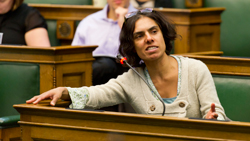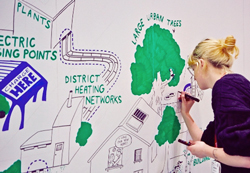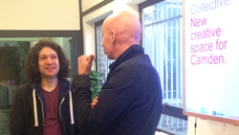In the first of a series of posts about her eight years as a Green Councillor in Camden, Maya de Souza writes about the influence Greens have had on planning in the borough:
 In my eight years as a councillor, initially with fellow councillors Adrian Oliver and Alex Goodman, we influenced planning policy as well as actual decision-making.
In my eight years as a councillor, initially with fellow councillors Adrian Oliver and Alex Goodman, we influenced planning policy as well as actual decision-making.
Our knowledge of the law and our determination to make an impact on policy has certainly helped. Good planning and good design is something we Greens are passionate about. Shaping our local environment and protecting our heritage is so important. We are also keen to use planning policy to protect our local shops and high streets and ensure, through section 106 payments or the community infrastructure levy, that developers provide affordable housing, open spaces and community facilities.
King’s Cross – To give some examples; early on as a councillor on the Development Control committee I considered an application for a building by Christopher Hatton school in the Holborn area that raised issues about the playground being overshadowed. I felt the answer must be to have roof gardens to compensate, given the pressure to build in the very urban parts of the borough. I raised the issue in committee, including when we were considering the Kings Cross development, and in discussions on the new Camden Planning policies. Roger Madelin, the Kings Cross developer, has taken this on board, and the policy was amended to included a reference to roofs for amenity spaces and food growing.
Basements – When the issue of basements first arose the planning department felt that it wasn’t a planning matter. It was for neighbours to manage through party wall agreements or standard negligence actions. I read the policy and disputed this interpretation. I argued that the impact on water movement and possible flooding of neighbouring property made this a planning issue. This is now accepted and the Council seeks independent reports on hydrological issues, regarding it as a relevant ground for refusal. I’ve also argued that, to ensure its independence, the council should commission the report itself at the applicant’s expense. This is now virtually accepted practice.
Change of use – In council discussions on change of use of the Torriano pub in Kentish Town, I realised there wasn’t enough protection for pubs with a community function, and argued for the inclusion of a stricter ‘change of use’ test in such circumstances. This, again, has become planning policy. I understand that this was helpful in resisting the application for change of use of the White Bear pub in Hampstead. In recent council discussions I argued, persuasively, for stricter protection that takes into account not only the community functions of pubs but also their heritage value.
Construction nuisance – Another issue we are proud of is insisting that, in special cases, construction issues are taken into account before a decision is made. This was of relevance in the Fitzroy Farm (Highgate) and Little Green Street (Kentish Town) applications. We argued that in some cases the construction nuisance was serious enough to justify the refusal of planning permission altogether. We also argued that granting planning permission and then, later, considering construction issues, always left the Council in a weakened position. This approach has been accepted, though officers need to be consistently reminded of it by vigilant councillors.
Local environment quality – These are some examples of our work, but there are many others – for example, challenging officers in planning decisions to ensure they have fully considered efficiency standards in buildings, biodiversity, flood resilience, green and open spaces and other issues.
The developer pays – I’d like to mention one notable example of the role of section 106, in which a developer makes a payment towards a neighbourhood amenity. In this case, Camden council, as the developer in Holly Lodge Estate, was persuaded to contribute to a new family centre building. It was the idea of a local resident. I pushed for it and was pleased to see it happen. Though councillor Sally Gimson may claim credit, it had been agreed long before she arrived in the area. There remains much to be done in terms of good use of section 106 funds and the Community Infrastructure Levy. We’d like to see innovative approaches, for example using some of the funds to pilot a small network of pipes for a combined heat and power system, an investment in our infrastructure that would create jobs and improve our homes.
Taking ownership – More recently, I’ve supported the neighbourhood forums as away of communities sharing the use and feel of the area. I see the forums as a way forward on decisions relating to better transport and streets, energy efficient homes, protecting parades of shops and space for business, as well as heritage and prized sites. In Highgate Ward, this would include the Mansfield Bowling Club site amongst others. I’ve worked with residents to develop a constitution for the forum that makes it inclusive and participatory.
We Greens have done a fair amount of work but more, lots more, remains to be done. Green councillors, with their knowledge, expertise and commitment, are well equipped to play this important role.
Maya de Souza
Camden, May 2014



